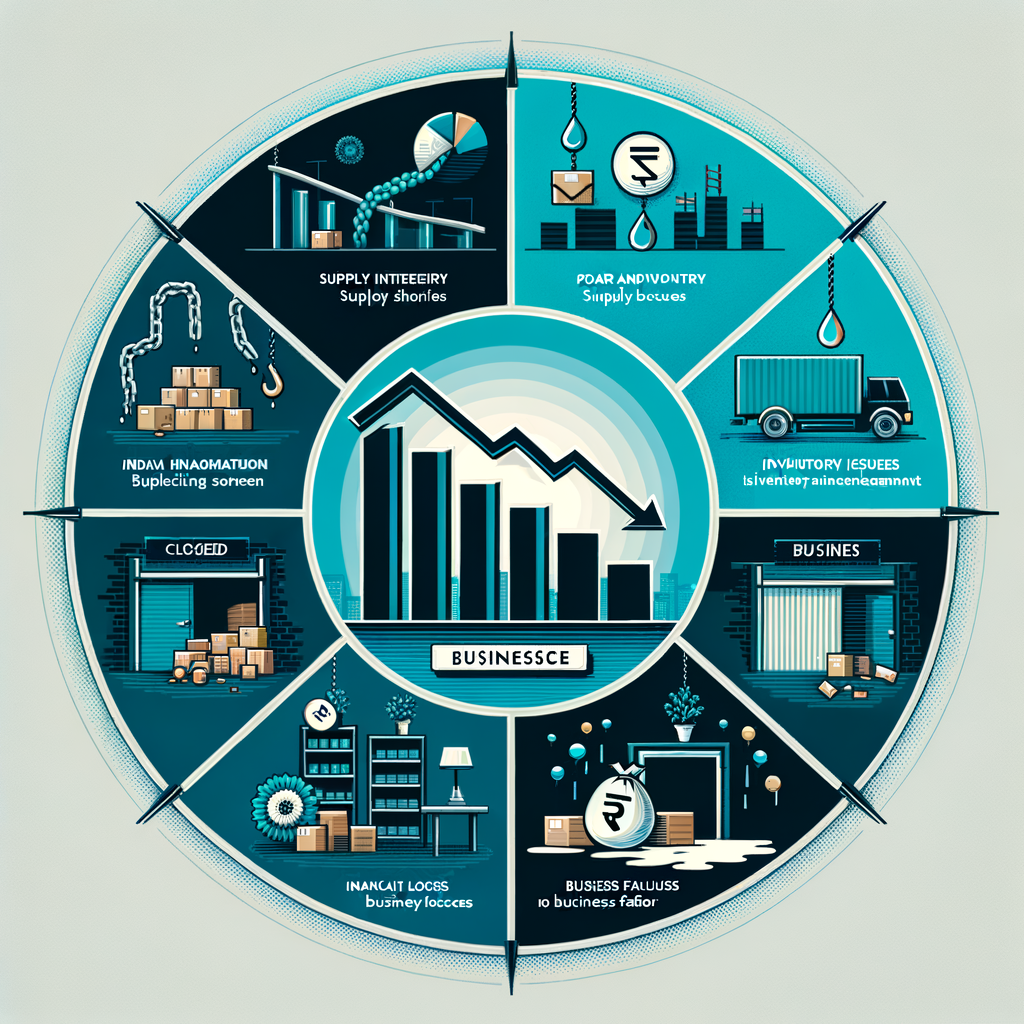How Can Poor Supplier and Inventory Management Cause Business Collapse? A Guide for Indian SMEs
Your sales are growing, but your profits are shrinking and cash is always tight. The culprit might not be your sales strategy, but two silent killers: your supply chain and your stockroom. Many small and medium-sized enterprises (SMEs) focus intensely on sales and marketing, often overlooking the operational backbone of their business. These internal inefficiencies are some of the most significant business collapse reasons in India, slowly and silently eroding the foundation of an otherwise healthy company. This article will break down exactly how poor supplier and inventory management can systematically dismantle a promising business. We will explore the specific challenges faced by businesses in India and provide actionable steps to safeguard your venture from this preventable fate.
The Domino Effect: How Poor Supplier Management Cripples Your Business
Effective supplier management is far more than just finding the cheapest price; it’s about building reliable partnerships that support your business operations. When these relationships are weak or mismanaged, the consequences ripple through every aspect of your company, causing financial and reputational damage that can be difficult to repair. The effects of poor supplier management in India are often underestimated, manifesting as production bottlenecks, angry customers, and severe cash flow problems. A single unreliable supplier can initiate a chain reaction, proving how supplier issues lead to business failure in India by disrupting your ability to deliver on promises made to your own customers. It’s a critical area where diligence pays dividends and negligence leads to disaster.
Unreliable Deliveries & The High Cost of Waiting
One of the most immediate consequences of poor supplier management is inconsistent and unreliable delivery timelines. When a supplier frequently misses deadlines, it throws your entire production schedule into chaos. If you are a manufacturer, you cannot produce goods without the necessary raw materials. If you are a retailer, you cannot sell products that haven’t arrived. This leads directly to stockouts of popular items. The result is not just a one-time loss of sale; it’s a cascade of negative outcomes. Frustrated customers who cannot find what they need will quickly turn to your competitors. Over time, your brand’s reputation for reliability erodes, and customers learn they cannot count on you to have products in stock, driving them away permanently.
Inconsistent Quality & Damaged Reputation
Receiving substandard raw materials or poorly made finished goods from a supplier is another critical failure point. The immediate impact is on your product quality. If you unknowingly use faulty components in your manufacturing process or sell a low-quality item to a customer, you are putting your reputation on the line. This leads to an increase in customer complaints, negative online reviews, and costly product returns or warranty claims. Each return not only costs you money in reverse logistics and refunds but also chips away at the customer trust you have worked so hard to build. In today’s digital age, a few bad reviews can significantly deter new customers, creating a long-term drag on your growth and profitability.
Price Volatility and Squeezed Profits
Over-reliance on a single supplier for a critical item creates a dangerous dependency. This supplier holds significant leverage and can dictate prices, knowing you have few alternatives. Unexpected price hikes can destroy your profit margins, especially if you operate in a competitive market where you cannot easily pass the increased cost on to your customers. Beyond direct price increases, poor supplier relationships lead to hidden costs. You might have to pay for expedited shipping to make up for a supplier’s delay or absorb the cost of replacing a batch of poor-quality goods. This financial strain puts immense pressure on a small business’s budget, making it difficult to invest in growth, marketing, or other essential areas of the business.
Critical Compliance Gaps: The GST Input Tax Credit (ITC) Trap
One of the most severe supplier management issues in India is related to GST compliance. The Goods and Services Tax (GST) regime has a mechanism called Input Tax Credit (ITC), which is vital for your business’s cash flow. Simply put, ITC is the tax you can reduce from your final tax liability because you have already paid it on your business purchases (inputs). However, you can only claim this credit if your supplier is also compliant—they must correctly file their outward supply returns (GSTR-1) and pay their taxes to the government. If your supplier fails to do this, your ITC gets blocked. This means the GST you paid on your purchases becomes a direct cost to your business, severely impacting your working capital and profitability. Before engaging a new supplier, it is crucial to verify their GSTIN and filing status on the official GST Portal.
The Hidden Costs: Unpacking Inventory Management Disasters in India
While supplier issues create problems on the sourcing side, what happens inside your warehouse is just as critical. The impact of poor inventory management in India is often a story of hidden costs that quietly drain your resources until it’s too late. Many businesses fall into the trap of thinking more stock is always better, or they fail to track their inventory accurately, leading to a host of problems. These inventory management challenges in India, from tied-up cash to lost sales, can become full-blown inventory management disasters if not addressed proactively. Managing your stock effectively is not an administrative chore; it is a core financial strategy for survival and growth.
The Cash Flow Killer: Overstocking and Dead Stock
Overstocking is one of the most common inventory mistakes. It occurs when you hold more inventory than you can sell in a reasonable period. This excess inventory, especially items that become obsolete or unsold for long periods, is known as ‘dead stock’. The primary danger of overstocking is that it traps your working capital. Every rupee tied up in unsold goods on a shelf is a rupee you cannot use for other critical business needs. For example, ₹50,000 stuck in unsold winter wear is ₹50,000 you can’t use for marketing, paying salaries, clearing rent, or investing in new, faster-moving products. Dead stock doesn’t just sit there; it actively costs you money and suffocates your business’s ability to be agile and responsive.
The Sales Killer: Understocking and Lost Opportunities
The opposite problem, understocking, is equally damaging. This happens when you don’t have enough stock of your best-selling products to meet customer demand. Every time a customer comes to your store or website ready to buy and finds the item out of stock, you lose more than just that one sale. You create a frustrating customer experience. A single stockout might be forgiven, but repeated occurrences will push even your most loyal customers to seek out more reliable competitors. This not only results in a direct and immediate loss of revenue but also damages your brand’s reputation and long-term customer loyalty. You are essentially doing marketing for your competitors by failing to meet the demand you created.
The Profit Eaters: High Holding Costs
Inventory isn’t free to store. The longer an item sits in your possession, the more it costs you. These “holding costs” are often overlooked but can significantly eat into your profit margins. For a small business, these costs include several components:
- Warehouse/Storage Rent: The direct cost of the physical space your inventory occupies, whether you rent a godown or use valuable retail space for storage.
- Insurance: You need to insure your goods against potential risks like theft, fire, or damage, and the premium is often based on the value of the inventory you hold.
- Spoilage & Obsolescence: For businesses dealing with perishable goods (like food) or items that can go out of style (like fashion or electronics), inventory has a shelf life. Any unsold item past its prime is a total loss.
- Administrative Costs: This includes the salary for staff required to manage, count, and organize the stock, as well as the cost of any management software.
The Vicious Cycle: How Supplier and Inventory Failures Feed Each Other
The most dangerous aspect of these operational failures is that they are not isolated problems. In fact, poor supplier and inventory management are deeply interlinked, creating a vicious cycle that can quickly spiral out of control and pull a business under. One issue directly causes or worsens the other, tightening the financial squeeze on your company until there is no room left to maneuver. Understanding this feedback loop is the first step toward breaking it. Breaking this cycle is absolutely essential for long-term business sustainability and supplier management.
This destructive cycle often plays out in a predictable pattern for many struggling SMEs:
- An unreliable supplier delivers a critical shipment late (supplier issue).
- To prevent future stockouts and angry customers, you decide to over-order the next time to create a “safety buffer” (inventory issue).
- This large order of safety stock now ties up a significant amount of your cash, leading to overstocking (inventory issue).
- With your working capital depleted, you struggle to pay your other suppliers—including the good ones—on time, potentially damaging those crucial relationships and risking your credit terms (supplier issue).
This downward spiral depletes cash, ruins supplier relationships, and bloats inventory costs, making it nearly impossible for the business to recover.
Building Resilience: Actionable Strategies for Indian Businesses
Escaping this vicious cycle requires a proactive and strategic approach. You cannot afford to be passive. By implementing disciplined processes for how you choose partners and manage your stock, you can build a more resilient and profitable business. Here are actionable strategies you can start implementing today.
For Smarter Supplier Management
- Vet Your Partners Thoroughly: Don’t let price be your only criterion. Before committing to a supplier, do your due diligence. Check their GST compliance history, ask for references to gauge their market reputation, and inquire about their average delivery track record. A slightly more expensive but highly reliable supplier is almost always a better long-term partner than a cheap but unpredictable one.
- Diversify Your Supplier Base: Avoid the risk of depending on a single source for any critical raw material or product. Actively cultivate relationships with at least two or three qualified suppliers for your key items. This gives you leverage in negotiations and provides a crucial backup if one supplier fails to deliver.
- Formalize Your Agreements: Move beyond verbal agreements and informal orders. Use clear, written purchase orders and contracts that explicitly outline your quality standards, precise delivery timelines, payment terms, and penalties for non-compliance. This formal documentation protects both parties and sets clear expectations from the start.
For Lean Inventory Management
- Track Everything Meticulously: You cannot manage what you do not measure. The first step is to gain full visibility over your stock. Even a well-organized spreadsheet is a powerful tool and infinitely better than having no system at all. List every product, track current stock levels, note purchase dates and costs, and record every sale.
- Adopt a Management Method: Implement a simple inventory management methodology. For businesses with perishable or time-sensitive goods, FIFO (First-In, First-Out) is essential. This principle dictates that you sell your oldest stock first, which helps prevent spoilage and obsolescence.
- Conduct Regular Audits: Your records are only useful if they are accurate. Conduct regular physical stock counts—weekly for fast-moving items, monthly for others—to ensure your records match the reality on your shelves. This practice helps you identify issues like theft, damage, or counting errors early before they become significant problems.
Leveraging Professional Help
Managing sales, marketing, finances, compliance, and operations all at once is a monumental challenge for any small business owner. Accurate accounting is the foundation of good inventory management. When your books are clean, you get a true picture of your COGS (Cost of Goods Sold), profit margins per product, and overall cash flow. This data is essential for making smart decisions about purchasing and stocking levels. This is where professional help becomes not a cost, but an investment. Services like TaxRobo’s Accounting and Auditing can ensure your financial data is precise and compliant, empowering you to make strategic decisions that drive growth rather than simply reacting to crises.
Conclusion
It’s time to stop viewing operational logistics as a secondary concern. As we’ve seen, poor supplier and inventory management are not minor issues; they are direct threats that can trigger a cascade of failures leading to business collapse. From crippled cash flow and devastating GST compliance gaps to a permanently damaged reputation and continuous lost sales, the stakes are incredibly high. The health of your stockroom and the reliability of your supply chain are direct indicators of the financial health and long-term viability of your business. Take proactive control of these critical areas before they take control of your business’s destiny. For expert guidance on building a financially sound and compliant business foundation in India, contact the experts at TaxRobo today.
Frequently Asked Questions (FAQs)
1. What is the first step to improve inventory management for a very small business?
Answer: Start simple. The most crucial first step is creating visibility. Use a basic spreadsheet to list all your products. For each product, create columns to track the current stock level, note purchase dates and costs from your supplier, and record every sale as it happens. The goal is to know what you have, how fast it sells, and when you need to reorder. Regularly updating this sheet is the foundation of all good inventory management.
2. How do I check if a supplier is GST compliant in India?
Answer: You can, and should, verify a supplier’s GST compliance before engaging them. You can check their GST Identification Number (GSTIN) and their return filing status directly on the official GST Portal using the ‘Search Taxpayer’ feature. This will show you if their registration is active and whether they have been filing their returns regularly. This is a critical due diligence step to protect your ability to claim Input Tax Credit (ITC).
3. What is ‘dead stock’ and how does it really harm my business?
Answer: Dead stock is inventory that has not sold for a long period and is now unlikely to sell at full price, if at all. It harms your business in two primary ways. First, it ties up cash: the money you spent to buy that stock is trapped on a shelf instead of being used for growth activities like marketing or developing new products. Second, it incurs holding costs: you are still paying rent, insurance, and administrative costs for items that generate zero revenue, actively draining your profits.
4. How can poor supplier relationships affect my ability to get a business loan?
Answer: When banks and lenders assess your business for a loan, they look for stability and predictable cash flow. Poor supplier management creates immense financial volatility. If your financial statements show inconsistent profit margins due to sudden price hikes, erratic cash flow from production delays, or potential liabilities from non-compliant suppliers (like blocked ITC which reduces profitability), it signals that your business is high-risk. A stable, well-managed, and compliant supply chain is a key indicator of a healthy, fundable business.



